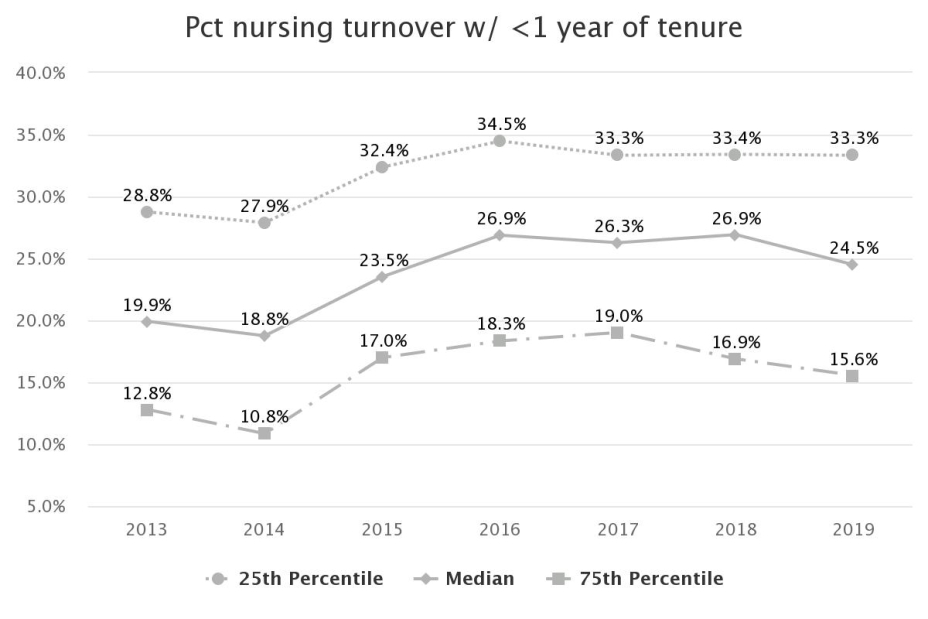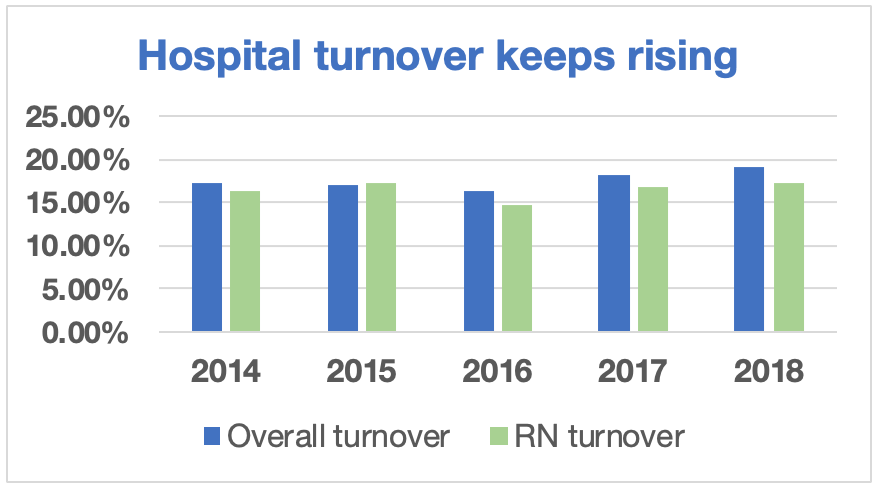Nursing Workforce Challenges: Turnover, Vacancy, Shortage
Excessive turnover across healthcare, and especially among RNs, has been an issue in health care for many years. In 2014, a 10-year study of new nurses by the RN Work Project, backed by the Robert Wood Johnson Foundation, reported that, on average, 17.5% of nurses in the study group left their first job within a year of being hired. Recent comprehensive survey data from the Advisory Board revealed even higher rates of <1 year turnover among nurses.

Source: Advisory Board
Today, the situation seems to be growing more acute as novice nurses outnumber experienced nurses, and turnover is highest among new nurses. As a result, an increasing number of hospitals (55.3%) had an RN vacancy rate higher than 7.5%.

Source: NSI 2019 National Healthcare Retention Report
Meanwhile, healthcare stood very close to full employment in June 2019, according to the U.S. Bureau of Labor Statistics (BLS). By 2026, the BLS projects the baby boom generation will create an influx of older patients and a simultaneous retirement of those available to care for them – resulting in a need for 15% more RNs than today.

Source: NSI 2019 National Healthcare Retention Report
The Impact of Nursing Workforce Challenges
A large body of research has tracked a direct effect of turnover on several measures of patient care. For example:
A greater number of patient-care hours performed by RNs per day is associated with better care for hospitalized patients. (Needleman, J., Buerhaus, P. Nurse-Staffing Levels and the Quality of Care in Hospitals. N Engl J Med 2002; 346:1715-1722)
Higher RN staffing correlates to reductions in hospital-related mortality, cardiac arrest, hospital acquired pneumonia, and other adverse events. (Kane R.L., Shamliyan, T., et al. Nurse staffing and quality of patient care. Evid Rep Technol Assess. 2007 Mar;(151):1-115.)
Nurse satisfaction with the work environment is closely aligned with patient satisfaction measures. (Peršolja M. The effect of nurse staffing patterns on patient satisfaction and needs: a cross-sectional study. J Nurs Manag. 2018 Oct;26(7):858-865.)
In addition, significant association exists between the actual vs. needed staffing levels and patient satisfaction. (Kutney-Lee A, McHugh MD, Sloane DM, et al. Nursing: a key to patient satisfaction. Health Aff. 2009;28(4):w669–w677)
type: asset-hyperlink id: 64v63JNHK7BaNS13bIwZcY about how one Arena Client––a regional, multi-location general hospital––boosted operations, employee performance, and patient care across departments by adding AI to combat turnover.
How Arena Works
All applicants are obliged to complete the Arena questionnaire online (6-8 minutes), which produces metadata about how applicants react in different situations. Arena analyzes this data along with outcome data collected from client's HR systems, and publicly available sources such as local and regional labor statistics, job boards, the Glassdoor website, and relevant market data.
All of this data is fed into algorithms that generate predictions for the likelihood that a particular prospective employee will stay and be a productive member of a team. The algorithms produce a score, which leads a candidate to be “recommended” or “not recommended.”
These predictions are highly specific to the candidate and the role being filled. The same person who thrives in a job in one unit of a hospital may not do well in the exact same job in another unit or another location.
The use of fresh outcome data continually updates the algorithms, improving accuracy and keeping pace with changes in the organization .
The Results
As a result of integrating Arena into the hiring process, healthcare employers are showing a notable increase in retention rates in the first 6-12 months, and reducing their reliance on premium contract labor.
“We eliminated our agency usage this year in all acute patient care units and emergency departments. We spent $7.2 million in fiscal year 2018 on traveling nurses and dropped that to $1.8 million by the end of the 2nd quarter in 2019. For 2020, we budgeted no agency nursing expense.”
Reducing turnover saves money. Not only do employers spend less time hiring and training new staff — which costs hundreds of thousands of dollars annually – they eliminated a major expense for agency nurses.
New Tools to Augment Good Hiring Decisions
These new tools of artificial intelligence do not replace the human factor in hiring, but the efficacy of the retention predictions has proven to be a valuable additional insight, one that augments good hiring decisions.
There is a sea of opportunity here. As health systems fine-tune the process of measuring clinical outcomes and patient experiences and can align this data with the attending staff, predictive scores of success can be generated that relate these outcomes to job candidates.
This is the future of hiring, to ensure we have staff who are best suited for challenging work while saving our health systems significant dollars that can keep the doors open and ready to serve the community.


![[object Object]](https://images.ctfassets.net/ucbt0bqomge5/6L6Ju8neARz05y4Iikgspa/1ac3bfcc510dab500ce6d6b0162ec76e/burnout-female-healthcare-worker-RESIZED.png?w=352&h=240&q=100&fm=png)